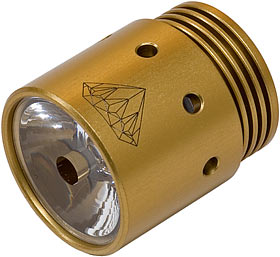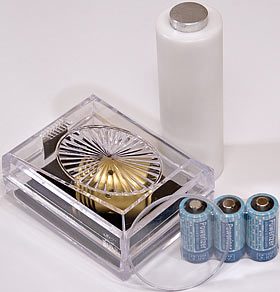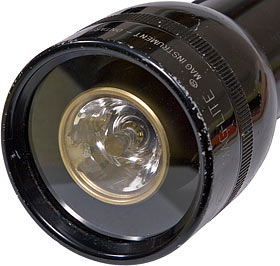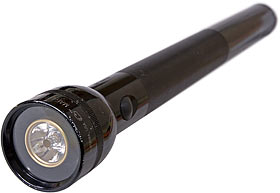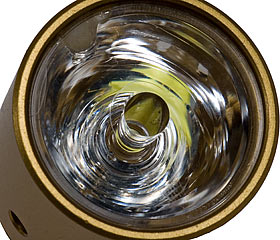
TerraLux DA-5W LED lamp
Review date: 26 August 2005.
Last modified
03-Dec-2011.
If, for whatever reason, you find yourself in need of a really big flashlight, there's one that stands above the rest.
Literally.
The smaller light in this picture is a LumaRay FL6. It takes three C cells, it's almost nine inches long. It's not tiny. It just looks that way, because it's got a six D cell Maglite next to it.
The 6D Mag is, I think, the most impressive whomper of a flashlight on the consumer market. It's almost half a metre long, and it's supposed to weigh more than 1.4 kilograms with batteries in it. This one actually weighs more than one and a half kilos (3.3 pounds) when packed with ordinary alkalines (PDF datasheet).
In stock trim, the monster Mag is a perfectly decent bright flashlight with an adjustable beam and long battery life. But it's also a mace in civilian clothes, which can come in handy for certain people in certain situations.
A 6D Mag is far too big to lug around all day, but it's a great light to keep in your home or vehicle for emergencies of whatever kind. Like all Mags, it's decently waterproof (though it definitely won't float) and highly corrosion resistant. And it's individually serial-numbered - my 6D is D61356916. That last part doesn't really matter, but it's still cool.
If a 6D Mag's just not scary enough for you in the first place, you can also get handles that turn these lights into police-style side-handle batons. The fancier handles go over the flashlight's switch and let you turn it on and off with your thumb on the end of the handle.
Put a handle on a 6D Mag and you've pretty much made a tonfa for ogres.
For what it is, the 6D Mag's also cheap. Without batteries, you're looking at only about $US25 for one, if you shop wisely. That's only a buck or two more than you'll pay for the standard security-guard two and three cell models. Here in Australia all Maglites seem to be considerably more expensive for no obvious reason, but they're still not luxury products.
Unfortunately, though, Mag Instrument are the Harley-Davidson of the flashlight world. They aren't keeping up with the times.
It's not insignificant that 1996 is the last year mentioned on Mag Instrument's rah-rah history page. It's not quite like graphing disco record sales only until the end of 1976, but '96 was three years after Shuji Nakamura's first blue LEDs went on sale. Water-clear high intensity LEDs were already starting to enter the flashlight market.
Mag's stubborn affection for incandescent bulbs - which can be had in much higher power ratings than any LED, but which deliver lousy uneven yellow light, and don't last anywhere near as long - is looking more and more primitive, even if it does help keep prices low.
(You get two bulbs with every Maglite; one lives in the tailcap. This was pretty cool in 1979, but today's consumer would rather not have to change bulbs in the dark, has room for a small amount of other stuff)
Since there are so very many Maglites out there, though, there's a thriving industry in replacement lamps for them. It used to just be higher powered incandescent bulbs (which Mag Instrument sell, too), but now there are plenty of LED lamps too.
I looked at some Mag-retrofit LED products a few years ago here, but things have moved on. TerraLux are a leading source of modern Mag-improvers, and they sent me a selection of their products.
Naturally, I started with the biggest and meanest one.
TerraLux call this the DA-5W; it's currently one of their "Hot Items". It costs $US79.95 - more than three times the price of the flashlight you put it in - but it packs one of Lumileds' mighty Luxeon V LEDs.
The Luxeon V is so named because of its five watt rated power.
Go back only four years, and the most severely overdriven single LEDs were drawing maybe a third of a watt. They weren't very efficient at that power level, and their lifespan was severely reduced; the "100,000 hour" lifespan that most LEDs have on their spec sheet is at the rated power, which for a standard 5mm LED isn't going to be more than a tenth of a watt. Super-LEDs like Lumileds' don't just handle more power, they handle it more efficiently, too; small LEDs are making great strides (as I discovered the other day) but, often, a Luxeon LED at its rated power will still give you more light per watt than a 5mm LED running at its, much smaller, rated power.
The Luxeon V has some other... personality features... that I'll get to in a moment.
First, the DA-5W and its many talents.
This lamp is actually a Diamond Flashlight product; my review unit came in Diamond packaging. That packaging's rather nice, though; a nifty little plastic box for the electronics, a new lens for your flashlight (in case your current one's all scratched up), three little batteries, and a plastic doodad.
These last items let you install the DA-5W in a Maglite that's meant to take only two D cells (there's a version for 2-C-cell lights, too). The little batteries are lithium CR123 cells, as seen in all kinds of high-powered "tactical" lights; you put them in the plastic dingus, then slide that into the flashlight's battery compartment.
CR123 cells, like most lithium cells, have a fresh unloaded terminal voltage up around 3.6V, and a nominal loaded output of 3V. So three of them roughly equal six 1.5V-nominal dry or alkaline cells. I'll get to exactly how roughly in a moment.
Installing the DA-5W in a Maglite isn't difficult; you just remove the head, unscrew the lens holder at the front of it, remove the reflector, remove the bulb from the flashlight, and screw the new lamp on where the bulb-holding collar used to be. Some LED replacement lamps will fit any flashlight that takes that kind of bulb; the DA-5W is made specifically for the Mag collar retention mechanism.
The installation instructions say the DA-5W replacement lens is glass, but it isn't; it's just another plastic disc. This is just as well, because the reflector is what normally holds a Maglite's front lens in place, by pressure around its edge. Without it, you just screw the end of the light on until the rim of the lamp pushes up against the lens. This works fine, but would be asking for trouble with a glass lens.
Making numbers
Mag Instrument's quoted peak beam power figure for the 6D Mag, with its standard bulb, is 30,000 candlepower. Which sounds like a lot. Thirty thousand candles under a boiler could run about a one megawatt generator, enough to power a few hundred houses.
Candlepower, though, is not what you'd call a totally straightforward unit. Basically, the tighter the beam, the higher the candlepower - which is why you can buy a "million candlepower" spotlight for $US20. Thirty thousand actual candles would throw light roughly equivalent to the 6D Mag's maximum narrow-beam output in all directions at once.
Those $20 spotlights (usually rechargeable, with lousy battery life) are great for spotting beasties or burglars at a distance, but as general purpose flashlights they're dreadful. Most of the time, you want a broad beam.
A standard Mag gives you the option of various beam widths, of course. At its tightest, with a somewhat tired standard bulb and six fresh alkaline D cells, the 6D Mag's beam peaked at better than 7000 lux at one metre, at its tightest setting. At that setting the main roughly circular "hot spot" beam is only around ten degrees wide, though - about a 20cm puddle of light at one metre. Twist the end to get maximum beam width and you get a it's a generous 115 degrees or so - a 130cm pool of light at one metre - but with a big dark "hole" in the middle. Like all affordable incandescent-bulb flashlights (and, apparently, standard military-issue ones in the year 2145), the Mag has uneven, yellowish output. It's never quite round, there are rings and holes at all beam settings, and brightness drops off precipitously as the batteries flatten.
When your nominal-1.5-volt batteries are down to, say, 1.2 volts per cell, an incandescent flashlight really is still outputting around two thirds as much light as it was at 1.5V per cell (not 80% as much, because lower battery voltage means lower current, and voltage times current equals power), but that light will have slid down the visible spectrum, with more of it falling right off the end into near-infrared; human eyes are less sensitive to red light, so flattening incandescent flashlights look dimmer than their raw power specs suggest.
The DA-5W mounted on a 6D Mag body gives a hybrid spot/wide beam; there's a small, mild hot spot in the middle that's only about six degrees across and scores a mere 400-odd lux at one metre, fading into a useful beam about 35 degrees across, with spill light all the way out to about 90 degrees. The hot spot only scores about 400 lux, with about 50 lux in the 35 degree beam, but this is a genuine useful broad beam with no hole in the middle.
Like all LED flashlights, the DA-5W gives much whiter output than a plain incandescent bulb.
But something is peculiar. The DA-5W uses a Fraen optic on top of its LED, instead of the smaller standard Lumileds "Star/O" optic. This lens gives a really tight beam with a Luxeon I or III. The DA-5W's hybrid beam is really nice, don't get me wrong, but why isn't it a spotlight?
Odd LED
The V is the black sheep of the Luxeon family. Essentially, Lumileds decided to make it before they were ready. The V was released after the I, and before the III; at the time, Lumileds couldn't make a single LED die that could handle much more than a watt.
Nowadays, the Luxeon III can do five watts pretty easily with adequate heat sinking, but at the time, Lumileds had no option but to stick four of their nominal-one-watt Luxeon I dies into one device, in a series-parallel arrangement. The Luxeon V is actually an array of two strings of two LEDs. The two-by-two die is much bigger than the dies of the single-LED Luxeons, and thus harder to focus; that's why the DA-5W doesn't have a tight beam.
It is, unfortunately, hard to keep a Luxeon V cool at anything like its rated power. This isn't a huge problem for coloured Vs, but is bad news for the phosphor on the white ones (which, like all other white LEDs, are actually blue LEDs with a colour-converting coating). As the phosphor dies, the LED gets bluer, and dimmer. Unfortunately, the phosphor doesn't just burn off; it turns into useless muck that gets in the way of the light.
Lumileds, as a result, only warrant white Vs for a lousy 500 hours of run time before the LED sags to half brightness, instead of the thousands of hours (at least) they give the rest of their products. TerraLux quote "100,000 hour life time" for the DA-5W, but that's presumably because they've absent-mindedly pasted in the standard boilerplate text for umpteen other LED lamps.
(Many other LED flashlights overdrive their lamps quite brutally, by the way; the ubiquitous "100,000 hours" spec doesn't take that into account.)
The LuxV datasheet (PDF here) says that as long as the heat sink plate on the back of the LED can be kept to no more than 35 degrees Celsius, the LED will still have 90% of its output left after 500 hours at rated power - but even that isn't too great.
Lumileds aren't quite sure what to do with Luxeon Vs. They created an artificial "V Portable" designation for white Vs so they wouldn't get mixed up with the longer-lasting coloured ones, then they put a couple of those LEDs back into the V Star category, as well.
Happily, plenty of people have reported much better than 500 hour life from white Luxeon Vs, or at least brightness degradation curves that suggest better performance than the warranty suggests. If you can actually keep the suckers cool, the phosphor won't get toasted. And the DA-5W has a hefty aluminium body with fins on the bottom and air holes around the sides. It's doing its best.
And LED lifespans aren't time-until-failure; they're time-until-some-particular-level-of-dimness, usually 80%. Yes, the white Luxeon V looks even worse if you apply that standard instead of 50%. But unless severely overdriven, LEDs will pretty much never just go pop and die, so you'll never be left in the lurch in the dark.
It should also be noted that incandescent flashlight bulbs are commonly rated for 30 hours of run time or less. 15 hours is far from unheard of, for very bright or very cheap models. Given the usual prices for decent quality flashlight bulbs, this can actually mean that they don't actually cost much less per hour than a $US80 LED lamp that dies completely after 500 hours. Which it won't.
But, nonetheless, if you intend to use a flashlight for hours and hours every night, a Luxeon V is probably not the lamp you want in it.
More occasional flashlight users, however, will probably be perfectly happy even with the worst-case 500-hours-to-50% output. Most of the world's D-cell Maglites only need their batteries changed every couple of years, if that; with that kind of usage, it'll take decades to get to 500 hours of on time.
The 123 alternative
So what if you don't want a flashlight that looks like a tree trunk?
Well, CR123 lithium cells are remarkable little things. They're definitely among the best batteries available to consumers today, if money is no object (otherwise, boring old carbon zinc is still a big winner). But battery technology today still, objectively speaking, sucks. Good lithiums give you maybe 300 watt-hours per kilogram, which is rather less than three per cent of the energy density of petrol. And 123s are small.
If you take the 3-CR123-adapter-in-a-2D-Mag option instead of using a 6D, you're replacing six fat alkaline batteries each with a nominal rating of something like 30.75 watt-hours (PDF datasheet here; 20.5 amp-hours at a nominal 1.5 volts gives 30.75 watt-hours, in Physics Experiment Land at least) with three tiny lithiums rated at something like 4.5 watt-hours each (datasheet here).
If you think that's likely to mean something of a reduction in run time, you're right. Nominal energy figures are fuzzy at best, but you can still expect six Ds to run a DA-5W for at least ten times as long as three 123s.
Exactly how long either set of batteries will run the lamp is hard to say, because as with all LED flashlights, the DA-5W lamp will keep emitting better-than-nothing light even when the batteries are pretty much flat.
Quite a lot better than nothing, actually. My old 6D Mag had been just sitting around with the same set of batteries in it for more than a decade, before I brought it back to life with the new lamp. Those old D cells measured around one volt per cell, but they still drove the DA-5W, which clearly includes a DC-to-DC converter to boost low input voltage, to better than 300 lux peak at one metre.
Well, they did when I shook the light and fiddled with the end-cap a bit. Those D cells have had a hard life, including at least one use of the flashlight as a tyre-iron-shifting hammer (in, need I even mention it, the rain), which event broke the filaments of both the main and spare bulbs. Such abuse left the cells rather shorter than they used to be.
But you get the idea.
If asked to name run times for the DA-5W with D cells and with 123s, I'd say you could expect something like a straight day of decent brightness from Ds, and a couple of hours from 123s. But there's really no clear cutoff point.
Overall
LED flashlight enthusiasts aren't fans of the white Luxeon V, for the abovementioned reasons. It's really not that bad a product, though, and the DA-5W's not a bad deal, for what it is. There's a good chance the lamp will retain most of its brightness after 500 hours of run time, and there's also a good chance that you won't have the light on for long enough to find out. If you're looking for a flashlight whose bulb won't go ping if you call upon it to serve as an percussive maintenance implement or weapon of war, a Mag with a DA-5W in it will definitely do the job, at a non-ridiculous price.
If you've already got a 2D or 6D Maglite sitting around somewhere, the DA-5W becomes an even better deal. The 2D option may not give you a ton of run time, but it will give you a fairly lightweight flashlight with great brightness and eternal shelf life (lithium cells are always rated for ten years of storage, and are likely to be fine for a lot longer) and brilliant low-battery performance. That's pretty much the ideal recipe for an emergency light, if you ask me.
I can't give the DA-5W an unconditional recommendation, but I nonetheless like it a lot.
Review DA-5W kindly supplied by TerraLux.

